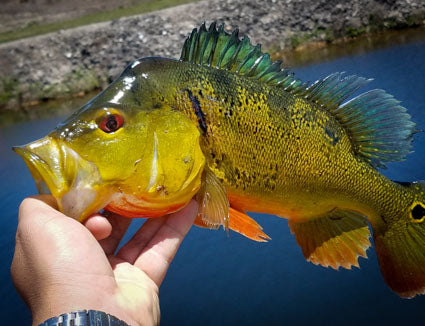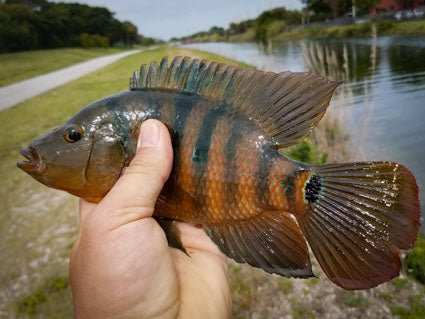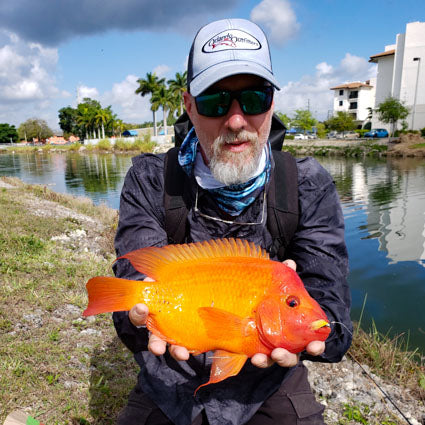South Florida has become known as a haven for a whole host of non-native and invasive fish. These species present some exceptional opportunities for fishermen looking forward to something different and challenging. Some of them require a bit of planning while others are widespread and easy to come by, but we’re going to get into greater detail in later installments. Right now, I want to introduce you to some of the main species you can expect to encounter on a regular basis.
Peacock Bass (Cichla sp.)
 Peacock Bass were first introduced to Florida canals back in the early 80’s and are the only species of cichlid that was intentionally introduced by the Florida Fish and Wildlife Conservation Commission. Originally stocked to help control the growing population of other non-native cichlids, peacocks have spread across the state from Miami to Naples. They can be predictably caught as far north as Del Ray Beach, all the way down into the Everglades. Colorful, aggressive, and very powerful, the peacocks will put a largemouth of the same size to shame, making them a highly sought-after species, especially for those of us who want to throw flies at them. Subsurface or topwater will work if you remember they hunt by ambushing, stalking, and chasing their food. Fleeing prey items get a whole lot more attention than those that are just standing still. Bedding peacocks are extremely protective and easy to catch once they reach their tolerance limit, leading conscientious anglers to seek more challenging quarry rather than risking the possibility that a mated pair will abandon the nesting site. Schools of juvenile peacocks wreak havoc on baitfish as they charge around looking for unwary prey, creating the perfect scenario for observant fly anglers. Florida peacocks have a lot to offer the adventurous angler even though they may not reach the epic sizes of their relatives in central and south America.
Peacock Bass were first introduced to Florida canals back in the early 80’s and are the only species of cichlid that was intentionally introduced by the Florida Fish and Wildlife Conservation Commission. Originally stocked to help control the growing population of other non-native cichlids, peacocks have spread across the state from Miami to Naples. They can be predictably caught as far north as Del Ray Beach, all the way down into the Everglades. Colorful, aggressive, and very powerful, the peacocks will put a largemouth of the same size to shame, making them a highly sought-after species, especially for those of us who want to throw flies at them. Subsurface or topwater will work if you remember they hunt by ambushing, stalking, and chasing their food. Fleeing prey items get a whole lot more attention than those that are just standing still. Bedding peacocks are extremely protective and easy to catch once they reach their tolerance limit, leading conscientious anglers to seek more challenging quarry rather than risking the possibility that a mated pair will abandon the nesting site. Schools of juvenile peacocks wreak havoc on baitfish as they charge around looking for unwary prey, creating the perfect scenario for observant fly anglers. Florida peacocks have a lot to offer the adventurous angler even though they may not reach the epic sizes of their relatives in central and south America.
Tiger Oscar (Astronotus Ocellatus)
 Many people will recognize oscars from their local aquarium stores, providing damning evidence as to how we come to find them in our Florida waterways. Accidental and intentional releases into a favorable Florida environment allowed this species to gain a solid foothold in our waterways but an intolerance to cold temperatures has kept their range limited to Lake Okeechobee south. I do, however, know where I can find a few here in the Orlando area. I believe they were released recently and are unlikely to last very long in a truly cold winter. They’ll eat just about anything available including insects, fish, shrimp, worms, and even bread. This puts them in competition with our native panfish species. Surprisingly they're not listed as an “invasive” species, leading one to believe that they aren’t causing too much trouble for the native inhabitants despite their stellar parenting skills, large numbers, and extreme appetites. Oscars love the shelter of lily pads and weedy cover where they can be spotted cruising around and hunting for food. Their top-oriented eyes dictate that they’re looking for prey items to descend from the surface, so that’s why small topwater poppers, slow-sinking spiders/insects, or relatively neutral minnow patterns can be so effective. Flies that sink too quickly will be followed to the bottom but rarely are they eaten. They are amazing fun for young anglers or people without much experience if they keep in mind that oscars do have some aggressive dorsal and pectoral spines that can inflict a painful puncture. I return from every trip south with a few more holes in my palms and fingers from re-learning that lesson.
Many people will recognize oscars from their local aquarium stores, providing damning evidence as to how we come to find them in our Florida waterways. Accidental and intentional releases into a favorable Florida environment allowed this species to gain a solid foothold in our waterways but an intolerance to cold temperatures has kept their range limited to Lake Okeechobee south. I do, however, know where I can find a few here in the Orlando area. I believe they were released recently and are unlikely to last very long in a truly cold winter. They’ll eat just about anything available including insects, fish, shrimp, worms, and even bread. This puts them in competition with our native panfish species. Surprisingly they're not listed as an “invasive” species, leading one to believe that they aren’t causing too much trouble for the native inhabitants despite their stellar parenting skills, large numbers, and extreme appetites. Oscars love the shelter of lily pads and weedy cover where they can be spotted cruising around and hunting for food. Their top-oriented eyes dictate that they’re looking for prey items to descend from the surface, so that’s why small topwater poppers, slow-sinking spiders/insects, or relatively neutral minnow patterns can be so effective. Flies that sink too quickly will be followed to the bottom but rarely are they eaten. They are amazing fun for young anglers or people without much experience if they keep in mind that oscars do have some aggressive dorsal and pectoral spines that can inflict a painful puncture. I return from every trip south with a few more holes in my palms and fingers from re-learning that lesson.
Jaguar Guapote (Parachromis Managuensis)
 Jags are one of our favorite species because of their secretive nature and the challenge associated with catching them. The casting distances aren’t much of a challenge but most of the time, getting a fly into the tightest spot possible is required. I think of them as a cross between a grouper and a tripletail because of their habit of keeping a roof over their heads while lying in wait for food to pass by. Brushy canal banks, rock outcroppings, floating weed mats, or even a floating piece of cardboard serves their purpose while increasing the challenge of getting a fly into just the right spot, especially in some of the backwater ditches and canals jaguars prefer. Most of the locations where we’ve found our largest jaguars aren’t the most picturesque fishing locales. You won’t see them on the cover of high-class fly magazines, but it’s about the fish in the case of Jaguar Guapote. Rarely will you see one sitting in plain sight, or frequenting high current areas, so you’ll need to do some homework and brush up on your casting skills to catch them on a regular basis. Like oscars, they also prefer a slowly sinking fly that gets their attention and remains in front of them for a period of time.
Jags are one of our favorite species because of their secretive nature and the challenge associated with catching them. The casting distances aren’t much of a challenge but most of the time, getting a fly into the tightest spot possible is required. I think of them as a cross between a grouper and a tripletail because of their habit of keeping a roof over their heads while lying in wait for food to pass by. Brushy canal banks, rock outcroppings, floating weed mats, or even a floating piece of cardboard serves their purpose while increasing the challenge of getting a fly into just the right spot, especially in some of the backwater ditches and canals jaguars prefer. Most of the locations where we’ve found our largest jaguars aren’t the most picturesque fishing locales. You won’t see them on the cover of high-class fly magazines, but it’s about the fish in the case of Jaguar Guapote. Rarely will you see one sitting in plain sight, or frequenting high current areas, so you’ll need to do some homework and brush up on your casting skills to catch them on a regular basis. Like oscars, they also prefer a slowly sinking fly that gets their attention and remains in front of them for a period of time.
Mayan Cichlid (Mayaheros Urophthalmus)
 Mayans are the most widespread of the non-native cichlids and are likely to be one of the first that anglers encounter. We even have a fishable population in central Florida along the east coast. Fairly aggressive, inquisitive, and hungry, this species readily takes flies of many types. They never cease to amaze me with their befuddling habit of chasing down with unbridled ferocity a quickly-stripped minnow pattern, yet backing away in abject fear from a perfectly-presented nymph or spider. These guys are the perfect ice breaker for someone looking to get into the cichlid game. They’ll guard a nesting site as a pair, attacking trespassers with gusto, they’ll chase and devour a wide variety of fly offerings, and like bluegill, they’ll sometimes attempt to eat a fly that’s much larger than will fit in their mouth.
Mayans are the most widespread of the non-native cichlids and are likely to be one of the first that anglers encounter. We even have a fishable population in central Florida along the east coast. Fairly aggressive, inquisitive, and hungry, this species readily takes flies of many types. They never cease to amaze me with their befuddling habit of chasing down with unbridled ferocity a quickly-stripped minnow pattern, yet backing away in abject fear from a perfectly-presented nymph or spider. These guys are the perfect ice breaker for someone looking to get into the cichlid game. They’ll guard a nesting site as a pair, attacking trespassers with gusto, they’ll chase and devour a wide variety of fly offerings, and like bluegill, they’ll sometimes attempt to eat a fly that’s much larger than will fit in their mouth.
Spotted Tilapia (Pelmatolapia Mariae)
 “Mood Fish” is what I call these guys because their coloration makes it obvious which one’s going to smack the fly that’s been audacious enough to invade its home. Fiercely territorial, these fish undergo a color change as they become irritated, going from a rather drab olive-green wallflower to a ruby-throated devil with fins. Although they can be caught at other times of the year by throwing insect, small minnow, and grass shrimp imitations, casting repeatedly to a bedding pair is the best method to ensure a strike. Unlike with bedding peacocks, I have no trouble trying to catch both of the bedding spotted tilapia because these are an unregulated species and you could keep every one you catch. You’ll find that catching the second fish after the first has been removed from the nest is nearly automatic because it seems that their paternal and protective instincts go into overdrive when they are the lone guardian. They can be a handful once hooked so it’s well worth the time invested.
“Mood Fish” is what I call these guys because their coloration makes it obvious which one’s going to smack the fly that’s been audacious enough to invade its home. Fiercely territorial, these fish undergo a color change as they become irritated, going from a rather drab olive-green wallflower to a ruby-throated devil with fins. Although they can be caught at other times of the year by throwing insect, small minnow, and grass shrimp imitations, casting repeatedly to a bedding pair is the best method to ensure a strike. Unlike with bedding peacocks, I have no trouble trying to catch both of the bedding spotted tilapia because these are an unregulated species and you could keep every one you catch. You’ll find that catching the second fish after the first has been removed from the nest is nearly automatic because it seems that their paternal and protective instincts go into overdrive when they are the lone guardian. They can be a handful once hooked so it’s well worth the time invested.
Midas Cichlid (Amphilophus Citrinellus)
 Midas’s are what I consider to be the toughest species of them all to catch but that’s part of what makes them so satisfying to successfully land. The midas come in a variety of colors but the one thing they all have in common is the habitat in which they live. The sheer rock faces of the Miami canal systems are perfect for this species. It’s not unusual to spot them suspended along the rock walls like big orange blossoms hanging from a trellis. Many of your presentations are straight up and down like jig fishing a reef and the take can feel like being snagged on a rock, but it’s all worth it once you have this beautiful species in hand. Rarely do you see them in the open and they’re loath to venture too far from the rock walls they call home, so be prepared to sacrifice a few flies in the process. I’ve learned they have a vise-like bite and are quite unwilling to let go of a fly once they have it, so don’t become too attached to your fly collection. The midas do prefer cleaner water conditions than many of the other species we talked about which means they aren’t quite as widespread and inhabit only canal systems with better than average or exceptional water clarity. All these issues just add to the thrill of the hunt.
Midas’s are what I consider to be the toughest species of them all to catch but that’s part of what makes them so satisfying to successfully land. The midas come in a variety of colors but the one thing they all have in common is the habitat in which they live. The sheer rock faces of the Miami canal systems are perfect for this species. It’s not unusual to spot them suspended along the rock walls like big orange blossoms hanging from a trellis. Many of your presentations are straight up and down like jig fishing a reef and the take can feel like being snagged on a rock, but it’s all worth it once you have this beautiful species in hand. Rarely do you see them in the open and they’re loath to venture too far from the rock walls they call home, so be prepared to sacrifice a few flies in the process. I’ve learned they have a vise-like bite and are quite unwilling to let go of a fly once they have it, so don’t become too attached to your fly collection. The midas do prefer cleaner water conditions than many of the other species we talked about which means they aren’t quite as widespread and inhabit only canal systems with better than average or exceptional water clarity. All these issues just add to the thrill of the hunt.
There are quite a few more exotic species to chase down south including bullseye snakehead, clownknife, convict cichlid, jewel cichlid, blue tilapia, the occasional pacu, walking catfish, black acara, and others but I’ve wanted to highlight the ones you’re most likely to encounter should you decide south Florida is the location for your next fishing journey. The Florida Fish and Wildlife Conservation Commission has even instituted a Big Catch Program for many of these non-native species as well as an Exotic Slam (Peacock, Mayan, Oscar all in one day) that anglers can apply for. Check out part two of this series where I’ll talk about the places these fish live. I’m not going to divulge any secret spots but I’ll try to make it easier for you to identify productive habitat and the fish that might be available.















Comments